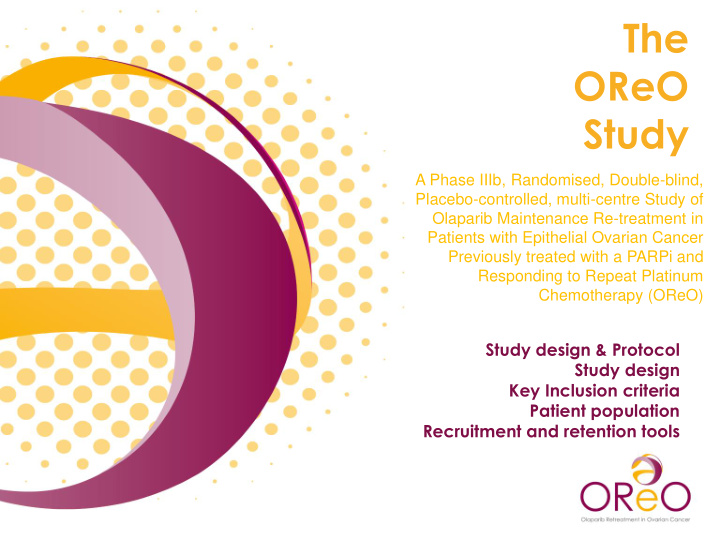



The OReO Study A Phase IIIb, Randomised, Double-blind, Placebo-controlled, multi-centre Study of Olaparib Maintenance Re-treatment in Patients with Epithelial Ovarian Cancer Previously treated with a PARPi and Responding to Repeat Platinum Chemotherapy (OReO) Study design & Protocol Study design Key Inclusion criteria Patient population Recruitment and retention tools
Ongoing Trials – status update OReO/GINECO ENGOT-ov38 Trial setting: non-mucinous EOC (including patients with fallopian tube and/or primary peritoneal cancer) Study Design: Phase IIIb, Randomised, Double-blind, Placebo-controlled , Sponsor(s): AstraZeneca Planned No. of patients: 416 Current accrual: First patient in June
OReO Study : Olaparib Retreatment in Platinum-Sensitive Ovarian Cancer PFS, TFST, FACT-O, Safety, AESI, OS • gBRCA+ or sBRCA+ R A (n=136) N • 1 prior PARPi treatment D - 18mo+ after 1 st line CT O - 12 mo+ after 2 nd line CT *300 mg bid or last tolerable dose Platinum-based M RP/RC 2:1 chemotherapy I Z • BRCAve- all-comers (no Bev) A (n=280) T • 1 prior PARPi treatment I - 12mo+ after 1 st line CT O - 06 mo+ after 2 nd line CT N Stratification factors • Prior bevacizumab • <3 vs ≥ 3 chemo lines
Rational of prior PARPi exposure time Median PFS of Study 19 (Olaparib) and NOVA (Niraparib) Patients According to BRCA Status and Treatment Arm, and Selection of Patients in OReO According to Previous Exposure to PARPi BRCAm BRCAm BRCAwt BRCAwt placebo arm Olaparib arm placebo arm Olaparib arm late relapse late relapse late relapse late relapse Median PFS (months) Study 19 4.3 11.2 5.5 5.6 NOVA 5.5 21.0 3.9 9.3 Selection in OReO according to previous > 12 > 6 PARPi exposure for relapse patients Selection in OReO according to previous > 18 > 12 PARPi exposure for first line patients Investigator meeting - 18/05/2017 4
STUDY DESIGN – BRCA1/2 (+VE) COHORT ➢ Response: CR or PR to most recent platinum CT (No Bevacizumab) ➢ Allowed subjects with additional line of chemo (+/- Bev) after PARPi and prior to most recent platinum-based chemotherapy ➢ Entry based on length of first PARPi exposure 136 patients patients in a 2:1 ratio BRCA+ 18mo+ after 1st line CT • 12 mo+ after 2nd line CT • R within 8 weeks Relapse * 1st line ≥ 18 months Chemo OReO olap./plac . Chemo PARPi Chemo PARPi Chemo OReO olaparib/placebo ≥ 12 months 2nd line Hazard ratio of olaparib maintenance versus placebo of 0.61 (corresponding to a median PFS of 12 months in placebo versus 24 months with olaparib) 5
STUDY DESIGN – BRCA1/2 (-VE) COHORT ➢ Response: CR or PR to most recent platinum CT (No Bevacizumab) ➢ Allowed subjects with additional line of chemo (+/- Bev) after PARPi and prior to most recent platinum-based chemotherapy ➢ Entry based on length of first PARPi exposure 280 patients patients in a 2:1 ratio BRCA-ve R 12 mo+ after 1st Line CT • within 8 weeks Relapse * 6 mo+ after 2nd line+ CT • 1st line ≥ 12 months Chemo OReO olaparib/placebo Chemo PARPi PARPi Chemo Chemo OReO olaparib/placebo ≥ 6 months 2nd line * an interval after stopping PARPi is allowed Hazard ratio of olaparib maintenance versus placebo of 0.73 (corresponding to 4.3 month (53.8%) increase in median PFS beyond the 8 months expected for patients on placebo) 6
STUDY OBJECTIVES Primary Objective : • To determine the efficacy of olaparib re-treatment compared to matching placebo by assessment of Progression free survival (PFS). Secondary Objectives: To determine the efficacy of olaparib re-treatment compared to • matching placebo by assessment of: Overall survival (OS) • the use of subsequent therapies and study treatment discontinuation • time to progression (TTP) by Gynecologic Cancer Intergroup (GCIG) • criteria To determine the Health-related Quality of Life (HRQoL) of olaparib re- • treatment compared to matching placebo as measured by the Functional Assessment of Cancer Therapy – Ovarian (FACT-O) Safety Objective: To evaluate the safety and tolerability of olaparib maintenance re- • treatment General safety (AEs/SAEs) • Advers events of special interest (AESI) • Clinical chemistry/haematology parameters (safety Lab data) • 7
Recommend
More recommend